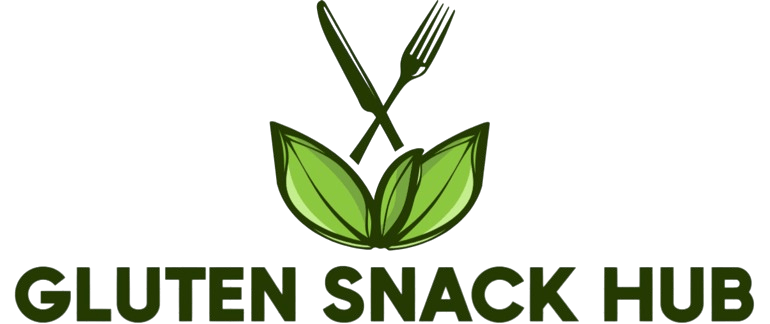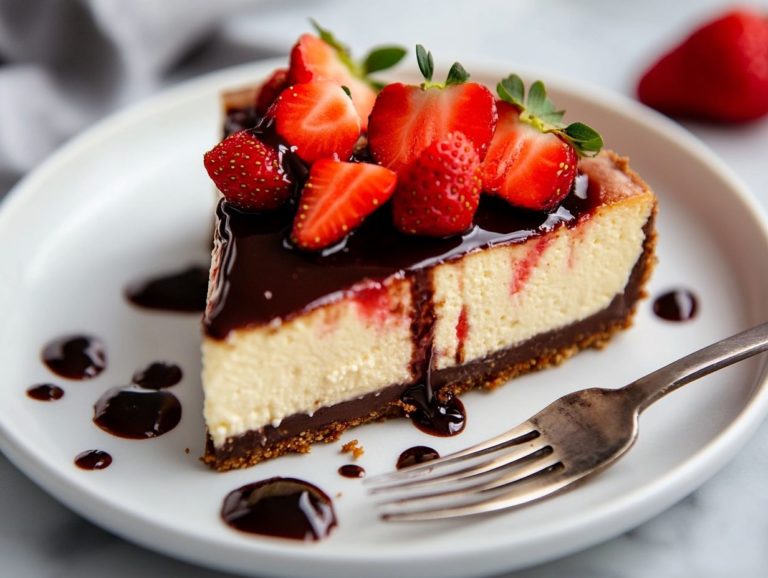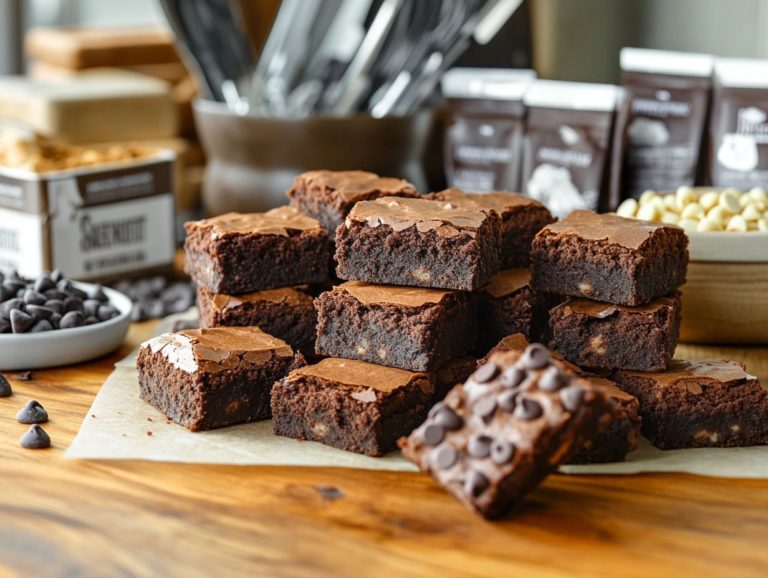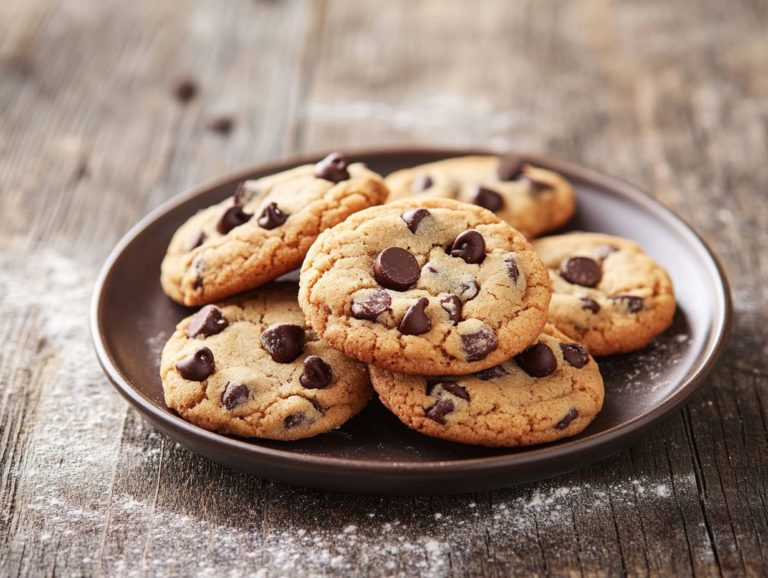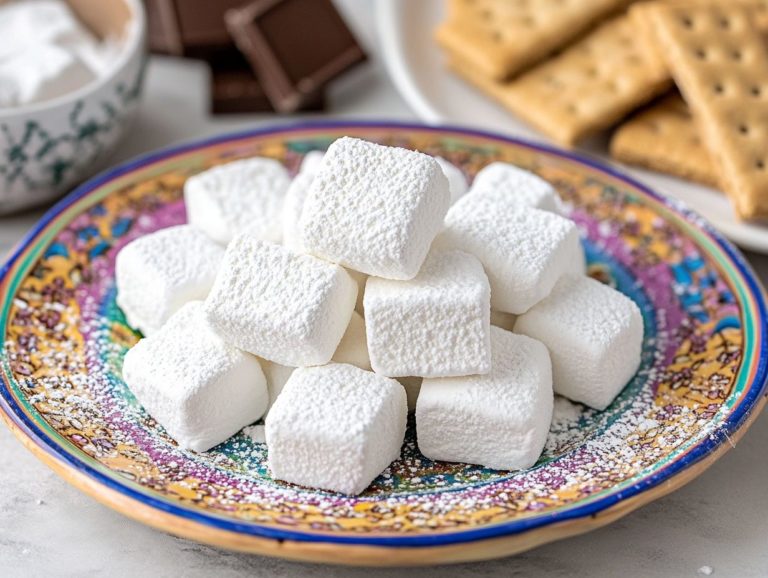The Science of Gluten-Free Baking
Gluten-free baking has surged in popularity as countless individuals embrace gluten-free diets, whether driven by health considerations, personal choice, or the need to manage gluten sensitivity or celiac disease.
But what precisely is gluten, and how does it influence the world of baking?
This article delves into the essentials of gluten-free baking, covering key ingredients, including gluten-free flours and alternative ingredients, the challenges you may encounter, and practical tips that pave the way for your success.
Whether you re just starting your gluten-free baking journey or seeking to hone your existing skills, you ll discover valuable insights and strategies to craft delectable, satisfying treats without a trace of gluten, using alternative flours and binding agents.
Contents
- Key Takeaways:
- What is Gluten?
- What is Gluten-Free Baking?
- Why Do People Choose to Bake Gluten-Free?
- What Are the Common Ingredients Used in Gluten-Free Baking?
- Nutritional Value and Tips for Successful Gluten-Free Baking
- What Are Some Tips for Successful Gluten-Free Baking?
- 3. Add Extra Moisture
- How to Convert Traditional Recipes to Gluten-Free?
- 1. Substitute Gluten-Free Flour
- Frequently Asked Questions
- What is gluten-free baking?
- Why is gluten-free baking important?
- What is gluten and why do some people need to avoid it?
- Can I substitute regular flour with gluten-free flour in any recipe?
- What are some common ingredients used in gluten-free baking?
- Can I still achieve a good texture and taste in gluten-free baking?
Key Takeaways:
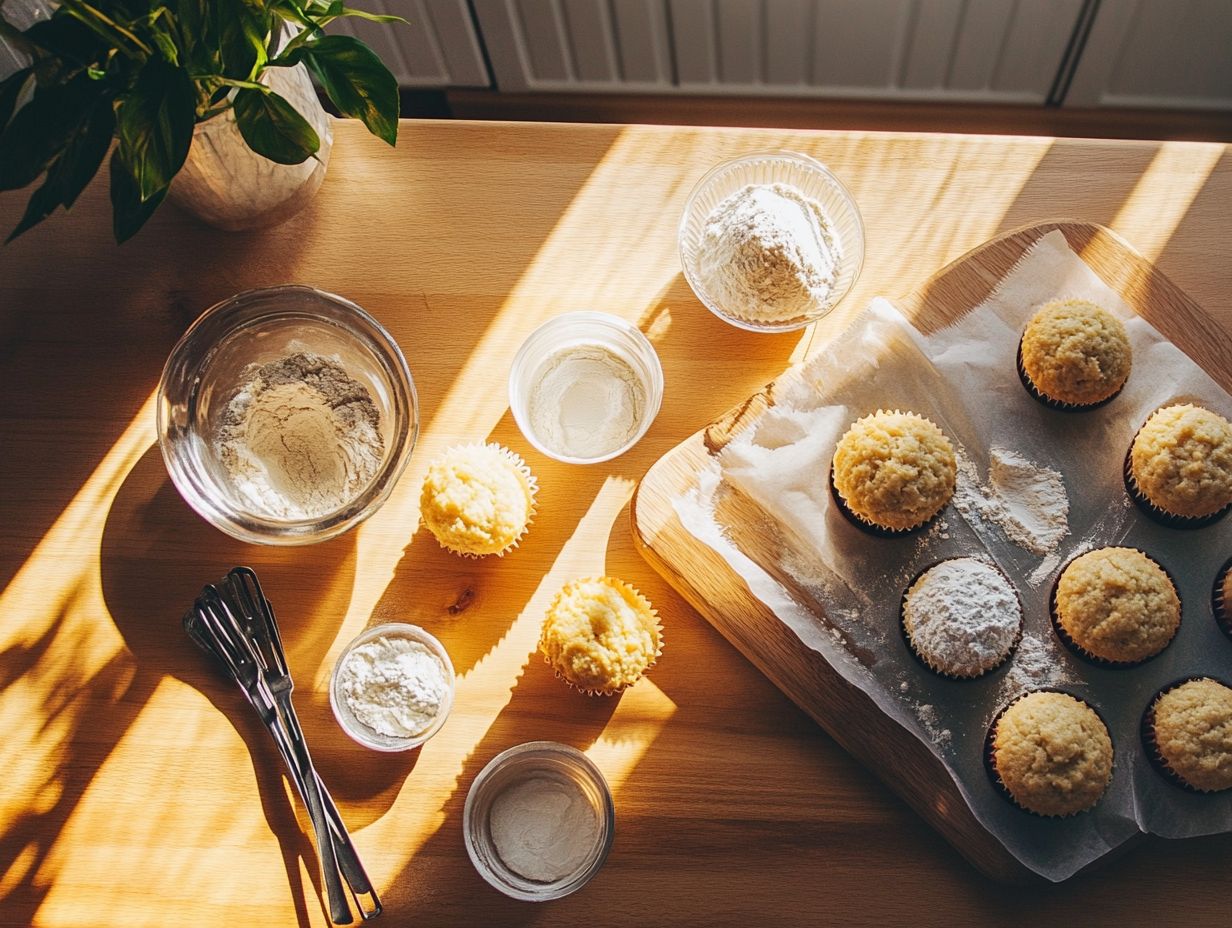
- Gluten-free baking uses alternative ingredients to replace gluten, a protein in wheat that can harm people with celiac disease or gluten sensitivity.
- Common ingredients include gluten-free flour blends, natural sweeteners, and dairy-free substitutes.
- Success in gluten-free baking requires experimentation and adjustments for the best texture and flavor.
What is Gluten?
Gluten is a protein found in wheat and its relatives, like barley and rye. It plays a critical role in shaping the texture and flavor of many baked goods.
While gluten provides that essential elasticity and structure to dough, it can also trigger adverse reactions in those with gluten sensitivity or celiac disease. This leads to a range of gastrointestinal and non-gastrointestinal symptoms that can significantly affect their quality of life.
Think of gluten as the binding agent that ensures bread rises perfectly and maintains its shape, giving that delightful chewiness to products like pizza and pastries. However, not everyone can indulge in these gluten-rich wonders. Those with gluten sensitivity might experience discomfort such as bloating and cramps. Individuals with celiac disease face serious damage to the small intestine from gluten consumption.
For these individuals, adopting a gluten-free diet becomes essential, paving the way for the evolution of gluten-free baking. This creative alternative involves using ingredients like almond flour, rice flour, and tapioca starch to replicate the textures and flavors they miss, enabling them to safely enjoy their favorite treats without worry.
What is Gluten-Free Baking?
Gluten-free baking is a refined craft that allows you to create delectable baked goods without incorporating gluten-containing ingredients. By harnessing the potential of gluten-free flours like rice flour, almond flour, and tapioca starch, you can achieve textures and flavors that closely resemble those found in traditional recipes.
This culinary endeavor not only caters to individuals with gluten sensitivity or celiac disease but also opens the door to a delightful array of gluten-free desserts, crusts, and pastries. All of this can be achieved while maintaining exceptional taste and quality, thanks to the artful use of baking techniques and flavor enhancements.
Why Do People Choose to Bake Gluten-Free?
You may choose to bake gluten-free for a multitude of reasons, often rooted in health considerations like gluten sensitivity or celiac disease. For those individuals, adhering to a strict gluten-free diet isn’t just a choice; it’s a necessity to avoid adverse reactions and foster overall well-being.
Some people choose gluten-free baking as a personal preference, viewing it as a healthier alternative that enriches their culinary experience. This approach allows you to explore new flavors and ingredients, transforming your kitchen endeavors into a delightful journey of discovery.
What Are the Common Ingredients Used in Gluten-Free Baking?
In gluten-free baking, you’ll find a delightful array of ingredients that replace traditional flour. Key players include rice flour, tapioca starch, and potato starch, all working together to lay the groundwork for your delectable baked creations while mimicking gluten’s essential properties.
To elevate your recipes, consider incorporating binding agents like xanthan gum or aquafaba. These additions, along with natural sweeteners and dairy-free substitutes, enhance moisture retention and improve texture and flavor, ensuring that your gluten-free treats are extraordinary.
1. Gluten-Free Flour Blends
Gluten-free flour blends are essential to your gluten-free baking endeavors. They mix various gluten-free flours like tapioca starch, rice flour, and almond flour to create the perfect texture and flavor in your baked goods.
These blends are crucial for replicating the properties of traditional wheat flour, which is vital for achieving delightful results. A common ratio for optimal results consists of 40% starch, such as tapioca, paired with 30% whole grain flour like brown rice flour, and another 30% nut flour, such as almond, for added richness.
The choice of flours significantly impacts your baking outcome, allowing you to achieve a delicate crumb and enhance moisture retention. Therefore, understanding how these various flours interact is key for anyone diving into gluten-free baking, as it directly affects both the sensory qualities and structural integrity of your final dish.
2. Alternative Binders
Alternative binders like xanthan gum are essential in gluten-free baking, as they replicate the elasticity and structure that gluten typically offers. This ensures that your baked goods hold together and achieve that coveted texture.
These binding agents play a pivotal role in moisture retention, enhancing the overall mouthfeel of your creations. For example, psyllium husk serves as a binder and retains water, preventing dry outcomes in breads and muffins. Similarly, chia seeds, when soaked, expand to form a gelatinous texture that effectively binds ingredients perfect for energy bars and cookies.
Consider incorporating aquafaba, the liquid from canned chickpeas, as a clever egg substitute in certain recipes. It adds delightful fluffiness, particularly ideal for meringues and cakes.
Each of these alternatives can elevate your gluten-free recipes by providing the necessary consistency and integrity, making your gluten-free baking endeavors more successful.
3. Natural Sweeteners
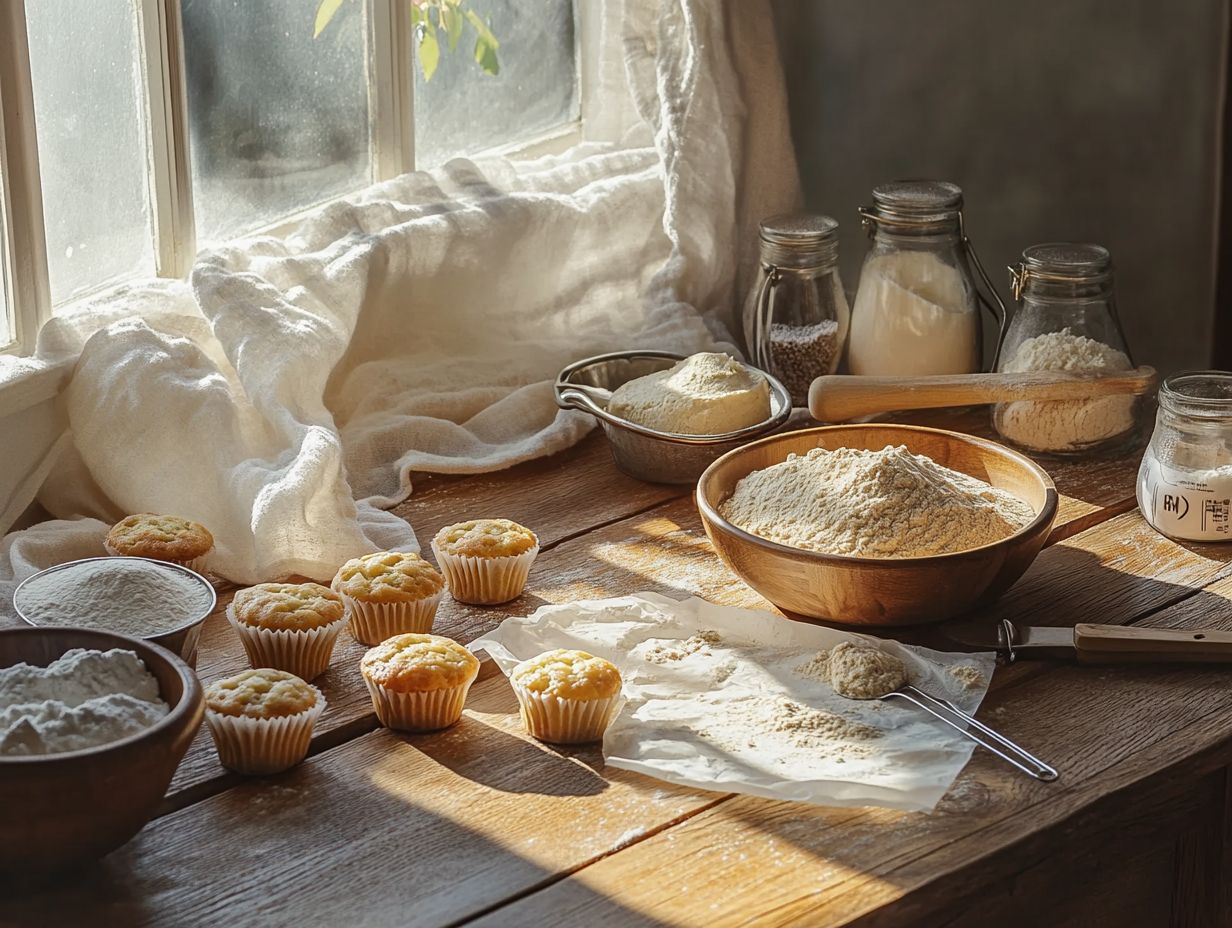
Natural sweeteners are essential in gluten-free baking, providing not just sweetness but also enhancing the flavor profile of your gluten-free desserts. Delightful options include honey, maple syrup, and coconut sugar, which incorporate baking techniques that balance flavor and moisture.
These sweeteners vary widely in taste and sweetness intensity. For instance, honey brings a lovely floral undertone, while maple syrup offers a rich, earthy flavor that can elevate your creations. Coconut sugar, with its subtle caramel notes, pairs beautifully with chocolate-based treats, adding depth without overpowering.
When substituting these sweeteners in traditional recipes, it’s crucial to understand their unique characteristics. Honey, being liquid, may require adjusting other liquids in the recipe, whereas coconut sugar generally mixes well with dry ingredients. To strike the perfect balance and maintain the desired texture without overwhelming sweetness, consider blending different sweeteners or adjusting the quantities. This approach ensures your baked goods stay moist and thoroughly satisfying.
4. Dairy-Free Substitutes
Dairy-free substitutes are gaining immense popularity in gluten-free baking, offering you delightful alternatives for butter, milk, and cream that cater to a diverse range of dietary needs and preferences. These substitutes not only enhance the flavor profile of your baked goods but also contribute significantly to their texture, making them tender and rich.
For example, you can replace cow’s milk with almond milk in recipes like pancakes or muffin batters. This adds a subtle nutty sweetness that elevates your dishes. Coconut oil is another fantastic option; it can take the place of butter, creating a moist and flavorful base for cookies or cakes. Its unique properties help achieve that perfect crumb.
Incorporating cashew cream can truly elevate your frostings and fillings, providing a creamy richness without any dairy involved. Recipes like gluten-free almond flour brownies or coconut oil chocolate chip cookies perfectly illustrate how these dairy-free ingredients work in harmony, resulting in delectable treats that everyone can savor and enjoy.
Challenges of Gluten-Free Baking
Gluten-free baking poses specific challenges, especially when it comes to achieving the texture and consistency that gluten typically delivers. To navigate these hurdles, you must thoughtfully consider your ingredient selections and refine your baking techniques.
Paying close attention to detail is key to success in overcoming potential shortcomings in flavor and moisture. This attention allows you to create delectable treats that truly satisfy.
1. Texture and Consistency
Achieving the perfect texture and flavor and consistency in gluten-free baking often presents a considerable challenge. The absence of gluten can result in crumbly or dry baked goods if you don’t effectively compensate with moisture retention techniques and proper binding agents.
To successfully navigate this hurdle, you must be discerning about the ingredients you select. Incorporating moisture-rich elements like applesauce, yogurt, or even an extra egg can significantly boost the moisture content of your batter. Certain gluten-free flours, such as almond, oat flour, or coconut flour, are particularly adept at retaining moisture, making them excellent choices for crafting that coveted texture.
To ensure your batter is just right, perform a simple consistency test check if it holds together without being overly wet or too dry. This small step can make a world of difference in achieving a soft, delightful final product. By mastering these moisture retention strategies, you can elevate your gluten-free baked goods to extraordinary new heights.
2. Flavor
Flavor can be a real concern in gluten-free baking. Without gluten, products can sometimes lack that delightful taste we crave. However, with the right combination of ingredients, you can create gluten-free treats that truly tantalize the taste buds.
Incorporating a variety of spices like cinnamon, nutmeg, and ginger can significantly elevate the flavor profile of your baked goods. Adding extracts such as vanilla or almond will bring depth and richness to the overall taste. Natural sweeteners like honey, maple syrup, or coconut sugar can enhance sweetness while adding unique flavor nuances.
Flavor enhancements like these are essential to strike a balance among these elements, ensuring that no single flavor overpowers another, which can often lead to bland or unappealing results. By experimenting with these ingredients, you have the power to achieve baked goods that not only meet dietary needs but also provide a delightful and enjoyable taste experience.
So, why not start experimenting with these delicious dairy-free substitutes today? Share your tasty creations and discover how rewarding gluten-free baking can be!
Nutritional Value and Tips for Successful Gluten-Free Baking
3. Nutritional Value
The nutritional value of gluten-free baked goods can vary significantly from their gluten-containing counterparts. Thoughtful ingredient choices are often required to maintain a balanced diet while indulging in delicious alternatives. This is particularly important for those with gluten sensitivity or celiac disease.
To strike this balance, consider incorporating a variety of nutritious components that elevate both flavor and health benefits. For example, using almond flour or coconut flour adds delightful taste and infuses healthy fats and proteins. These components help you feel fuller and provide sustained energy. Other alternative flours, like rice flour and quinoa flour, can also contribute to a well-rounded nutritional profile.
Incorporating ingredients like ground flaxseeds or chia seeds boosts the fiber content while delivering essential omega-3 fatty acids. When crafting your gluten-free recipes, blending different flours, such as brown rice or quinoa flour, can create a more nutrient-rich profile. Gluten-free flour blends can ensure a balanced mixture of textures and flavors.
Don’t overlook the potential of fruits, nuts, and seeds; they can enhance both the taste and nutrition of your baked goods. Embracing gluten-free baking can be a rewarding endeavor that beautifully supports your healthy lifestyle.
What Are Some Tips for Successful Gluten-Free Baking?
Successful gluten-free baking depends on your ability to grasp and implement certain techniques. This includes accurately measuring ingredients with a kitchen scale and fine-tuning hydration ratios to achieve the perfect texture in your baked creations.
Understanding the role of chemical leavening agents, such as baking powder and baking soda, is also key. These help achieve the desired rise and texture in your gluten-free desserts.
1. Use a Kitchen Scale
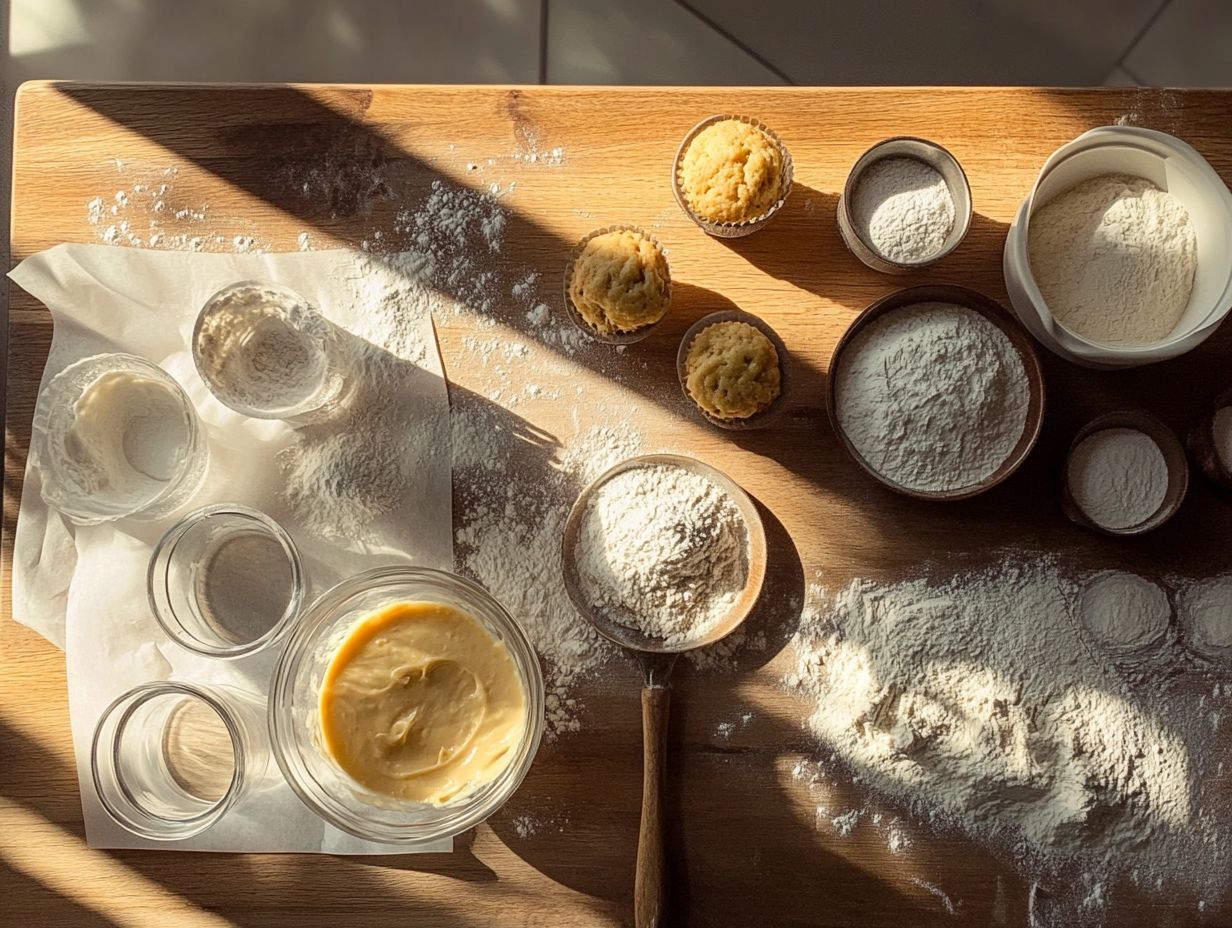
Using a kitchen scale is essential for your gluten-free baking endeavors. It allows for precise measurement of ingredients, which can dramatically influence the outcome of your baked goods and ensure proper hydration ratios.
When you re baking without gluten, measuring every ingredient with exactitude prevents dense or crumbly textures that could ruin your delightful creations. Many baking enthusiasts find that relying on volume measurements like cups and tablespoons can be misleading due to variations in how ingredients are packed or leveled.
By opting for a kitchen scale, you can confidently weigh out flours, sugars, and liquids, resulting in more consistent and rewarding outcomes. This approach is particularly advantageous for gluten-free flours, which often have different densities. Weighing them ensures that your recipes are both adaptable and replicable, especially for gluten-free flour blends, which must be measured accurately to maintain consistency.
Embrace this powerful tool and discover the joy it brings to your baking!
2. Experiment with Different Flours
Experimenting with different gluten-free flours is essential for uncovering new textures and flavors in your baked goods, as each flour offers unique characteristics. Exploring alternative flours like potato starch or rice flour can further diversify your gluten-free baking adventures.
Incorporating alternatives like almond flour, which imparts a subtly sweet and nutty flavor, or coconut flour, celebrated for its remarkable absorbency, can elevate even the simplest recipes. Buckwheat flour brings robust earthiness to the mix, while tapioca flour enhances chewiness, making it an excellent choice for certain pastries.
By blending various flours, you can achieve the perfect balance that accommodates dietary needs while enhancing the overall culinary experience. This process truly elevates the art of gluten-free baking.
Exploring these options will ignite your creativity and unlock an entirely new realm of gluten-free baking possibilities. What gluten-free creations will you try today?
3. Add Extra Moisture
In gluten-free baking, adding extra moisture is essential to counteract the tendency of gluten-free flours to yield dry or crumbly textures. This leads to a more enjoyable final product.
To achieve this, consider incorporating various ingredients that naturally bring moisture to the mix. Applesauce is a fantastic option; it enhances the texture and imparts a subtle sweetness. Another excellent choice is yogurt, which offers a creamy consistency while contributing beneficial probiotics for added health advantages.
Exploring the use of aquafaba can also serve as an excellent moisture retention method while maintaining a gluten-free profile. Don t overlook the importance of adjusting the liquid content in your recipe whether it s water, milk, or a dairy-free alternative as this can significantly influence the final outcome.
During the mixing process, pay close attention to the batter or dough; it should be thick yet pourable. If it seems too dry, add a small amount of liquid gradually until you achieve the desired consistency for optimal results.
How to Convert Traditional Recipes to Gluten-Free?
Converting traditional recipes to gluten-free is a rewarding challenge. Explore the art of substitution by replacing gluten-filled flour with gluten-free alternatives and selecting suitable binders.
This thoughtful approach guarantees you’ll create a delicious final product that’ll impress everyone while maintaining an appealing texture.
1. Substitute Gluten-Free Flour
When substituting gluten-free flour in your favorite traditional recipes, selecting the right flour blend is crucial to achieving the desired texture and flavor. Not all gluten-free flours can be swapped in equal measure.
The properties of gluten-free flours can differ significantly; for example, some might be heavier or drier than their gluten-containing counterparts. Many home bakers like you experiment with various gluten-free options, often turning to pre-made blends that combine multiple flours such as almond, coconut, or brown rice.
Opting for a blend specifically designed for baking cakes can yield a crumb that closely resembles that of traditional flour. Adding tapioca starch can help achieve a chewy texture reminiscent of bread. Incorporating psyllium husk or xanthan gum enhances elasticity and binding in your baked goods, elevating your culinary creations to new heights.
2. Use Alternative Binders
Incorporating alternative binders like xanthan gum or psyllium husk is essential when you’re converting traditional recipes to gluten-free. These ingredients provide the structure and texture that tend to vanish without gluten.
These binders serve as substitutes for the gluten proteins that create elasticity and cohesion in baked goods. This ensures that your final product holds together beautifully and has that satisfying bite. Experiment with the ratios to find what works best for you; too much can lead to an undesirable gummy texture, while too little might leave you with a crumbly mess.
A good starting point is 1 teaspoon per cup of flour, adjusting as needed based on your specific recipe and personal taste. Keep in mind that humidity and other factors can affect how well these binders work, so pay close attention to the dough’s consistency during preparation.
3. Adjust Baking Time and Temperature
When converting traditional recipes to gluten-free, you ll often need to adjust the baking time and temperature. Gluten-free baked goods can behave quite differently and may require less or more time in the oven for optimal results.
This variability comes from the different qualities of gluten-free flours, which absorb moisture in their own distinctive way. This ultimately influences the overall structure of your baked dish. For instance, when baking gluten-free bread, it might be advantageous to slightly increase the temperature and monitor the baking time closely, often starting with 5 to 10 minutes less than what the original recipe suggests.
For other treats like cookies, many bakers find that lowering the temperature yields a better texture without the risk of overbaking. To determine doneness, pay attention to visual cues such as a golden-brown color and a slightly firm surface. A toothpick inserted into the center can be a reliable method for checking; if it comes out clean or with just a few moist crumbs, your baked good is ready to cool.
Frequently Asked Questions
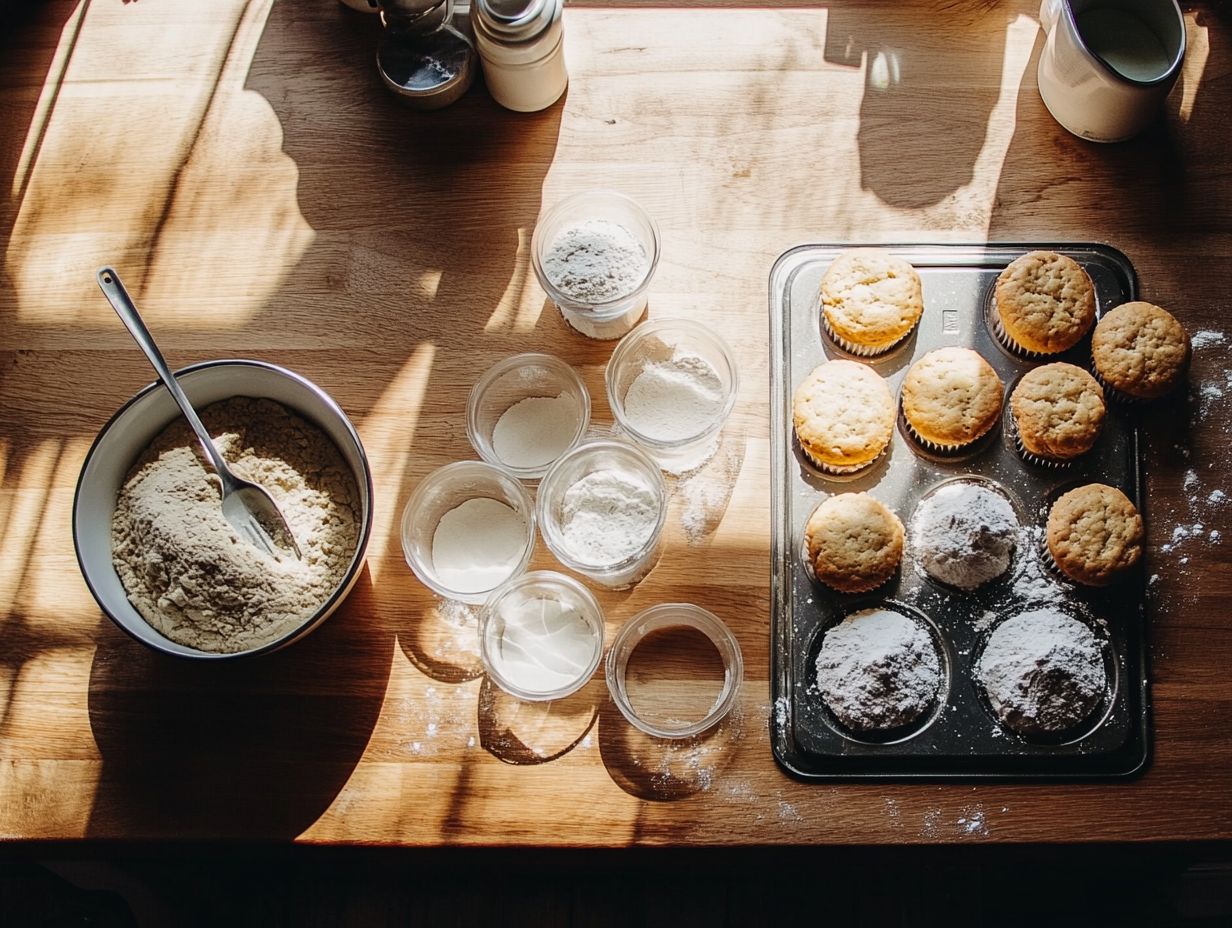
What is gluten-free baking?
Gluten-free baking is a type of baking that eliminates the use of gluten-containing ingredients, such as wheat flour, to create food products that are safe for individuals with celiac disease or gluten intolerance to consume.
Why is gluten-free baking important?
Gluten-free baking is important for individuals with celiac disease or gluten intolerance because consuming gluten can cause serious health issues for them. Removing gluten from their diet can improve symptoms and lead to a better quality of life.
What is gluten and why do some people need to avoid it?
Gluten is a protein found in wheat, barley, and rye that helps give dough its elasticity. Some people need to avoid it because their bodies cannot properly digest it, leading to various health issues.
Can I substitute regular flour with gluten-free flour in any recipe?
No, it is not recommended to simply substitute regular flour with gluten-free flour in any recipe. Gluten-free flour has different properties and behaves differently in baking, so it is important to follow a specific gluten-free recipe for the best results.
Ready to try your hand at gluten-free baking? Check out more recipes and tips to get started!
What are some common ingredients used in gluten-free baking?
Common ingredients in gluten-free baking include rice flour, almond flour, tapioca starch, and potato starch.
Xanthan gum is also important. It helps copy the texture and structure of traditional baked goods.
Can I still achieve a good texture and taste in gluten-free baking?
Absolutely! With the right mix of gluten-free flours and other ingredients, you can create delicious and satisfying baked goods.
Experimenting with various recipes can lead to exciting results!
